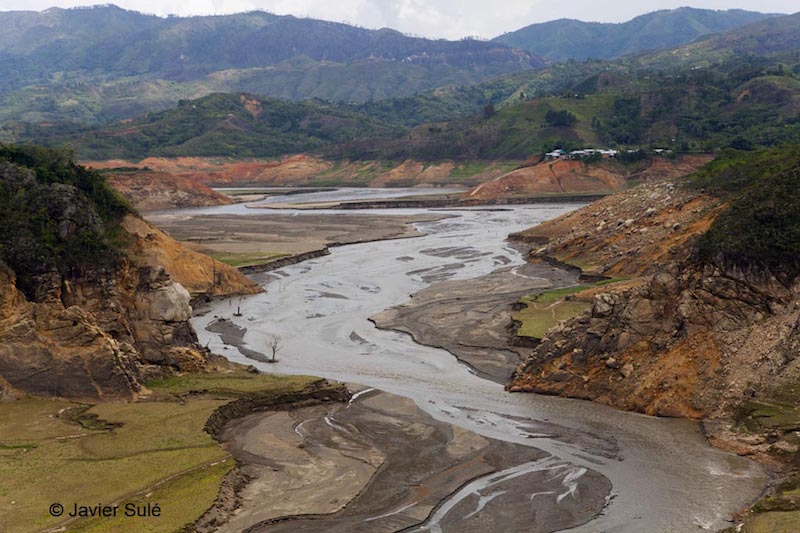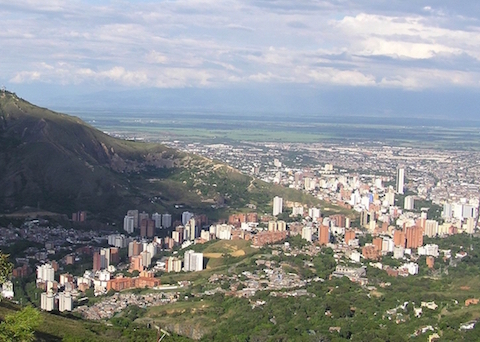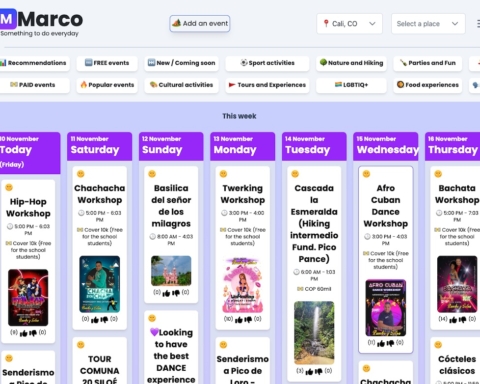I woke up this morning to the view of a dark and overcast sky. After six months with very little rain, I was hoping for a torrential shower. By noon it had yet to happen. After lunch, the sun had burned through the clouds and a clear blue skyline began to appear. It seems to be a story that repeats itself.
Few people worry about the water levels in their city… that is, until they begin to feel the effects. For the last couple of months, at my house, we’ve had several weeks of water rationing. For 14 days straight, the water was only opened from 6-8AM and again from 6-8PM. Cleaning the toilets meant collecting buckets of water in the swimming pool. No fun at all. And we’re some of the lucky ones. In barrio Siloé they don’t open the water at all running from the faucets. Instead, a 10.ooo gallon water truck enters the neighborhood every two days. Entire families go with their buckets to fill up and make sure they have enough to survive two days worth of drinking, cooking, showering, cleaning, doing laundry and flushing toilets. And if you’re weren’t home when the truck arrived, you’ll have going 4 days with no running water. No need to say, it’s a mess.
Wondering if it had always been like this, I asked my girlfriend if 40 C° weather and 6 consecutive months without rainfall is normal for Cali? She says that there has always a few months during the summer with very little rain, but for the last five years every summer has been longer, hotter and drier than the previous. Even the Caleños are beginning to wonder. Every day I hear the same conversation starting with somebody proclaiming ¡Qué calor!
The institute for Hydrology, Meteorology and Environmental Studies, IDEAM, confirms this fact, stating that rainfall in the Andean and Caribbean regions have fallen as much as 70%, due to the climate phenomena known as “El Niño”.
The rivers & dams
75% of the water that the Caleños consume comes from Rio Cauca. According to the local environmental organization, CVC, this is the current status for the local rivers, that supply Cali’s water:
- Río Cauca: 67 m3 x second. Historical average is 120 m3 x second. A 44% reduction.
- Río Cali: 0,55 m3 x second. Historical average is 3,44 m3 x second. An 84% reduction.
- Río Meléndez: 40 liters x second. Historical average is 800 liters x second. A 95% reduction.
- Río Pance: 1,30 m3 x second. Historical average is 3,8 m3 x second. A 65% reduction.
- Río Claro: 0,9 m3 x second. Historical average is 8,2 m3 x second. An 89% reduction.
- Río Pichindé: 0,62 m3 x seg. Historical average is 2,47 m3 x second. A 74% reduction.
70% of Colombia’s electricity comes from hydroelectric plants. The dams at Lago Calima, northwest, and La Salvajina, south of Cali, are the two main sources of energy for the entire valley. Both are drying out. La Salvajina reports that water levels are at a mere 22% of their regular capacity. Normally 40 cubic meters of water flows through their turbines per second. That number is down to 25 today. They estimate that unless rain starts falling soon, they could be out of water by December. Soon, brushing our teeth may not be our only worry. Keeping the lights on and your fridge cold could also become an issue, although the Colombia Ministry of Mining and Energy promises that there will be no energy cuts. The last time Colombia was forced to cut electricity was back in 1992.*
Emcali is the public provider of water and electricity in Cali. About 70% of Cali’s electricity comes from the dams, but the remaining 30% has to bought and imported from the energy markets. Prices have already gone up 3,5% for estrato 1,2 and 3 and 9% for estrato 4,5 and 6. Emcali claims that the only way to change people’s behavior is by cutting off the water or raising prices. I believe them. By Emcali’s calculations, a family of five should need no more than 32 cubic meters of water per month. To disincentivize excessive consumption, car-washing, flower-watering, etc., families crossing the 32 m3 monthly limit will be paying 100% extra per additional m3. Seems fair enough. In our house we spend an average 16 m3 of water per month for 4 persons and that includes two showers per day for everybody.
The long-term solution
Although we can’t change the weather, we can change our behavior.
Another reason that Cali has to ration its water is that a lot of the water available is contaminated to a point where cleaning it has become very hard. Illegal mining has filled the rivers and streams with mercury, and in many places the water is outright filthy due to excess garbage emptied into the water. According to this article, a massive 100 tons of garbage are thrown into Cali’s open sewers and water channels every single day. It’s a sad sight… take a look here to see what a simple search on Google displays.
Obviously, the first step is education. Present and future generations need to understand the importance of a clean water supply. Not just for us humans to survive, but also for the entire ecosystem to function well. Using the planet’s rivers and ocean as a trash can is one of the surest ways to speed up our own self-destruction.
The other day, I watched an eye-opening documentary, called Cowspiracy (free to watch on Netflix). In it, amateur investigator Kip Andersen, explains how he was taking short showers, buying economy-flush toilets and so forth in the name of preserving water. I won’t spoil all of the facts listed in the movie, but Kip began to research who consumes most of our water. What he found was that animal agriculture in the US consumes a whopping 80-90% of all water being used. Just growing the feed crops for livestock consumes 56% of all water in the US. Even though the number in Colombia is probably not as high, I’m sure it’s substantial.
Listen to these 3 simple facts from Cowspiracy:
- It takes about 1000 gallons of water to produce 1 gallon of milk
- It takes about 2500 gallons of water to produce 1 pound of beef
- It takes about 477 gallons of water to produce a pound of eggs
Then think about this: In 1927, the entire planet’s human population was 2 billion. It took 123 years to reach that number from 1 billion. Today, we’re more than 7 billion people and adding almost a billion more to the equation every 10 years.** A cattle farmer needs 2-5 acres of land per cow. A vegan can live all year of as little as a few hundred square meters.
If we want to make sure that there will be food for our future generation, it makes sense to switch to a more vegetable-based diet. While it might be utopia to believe that the entire world’s population would become vegans, one could start with eating 70% vegetable-based based. It’s also a lot healthier for you…
Until then, let’s all pray for a little rain in Cali. If not, it’s sure gonna be a long winter.
*Source: Q’Hubo newspaper, Oct 7, 2015. “¡Salvajina está grave!”.
**Source: United Nations, World Population Prospects
Photo credits: “La Savajina” by freelance journalist and photographer, Javier Sulé. Reach out to him via Twitter @JavierSule and check out his blog with lots interesting articles and photos from all over Colombia.









I’m not a cow rancher or a farmer, but I did have have 50 chickens in my backyard. They produced 3-5 dozen eggs a day, and I had one water can for them. They drank 2 gallons a day .So I’m not so sure about your facts…
Hi Robert!
Thanks for commenting. These numbers are not based on my own personal guesses – but if you didn’t care to click the source, I’m adding it here for your convenience.
The water needed to produce eggs, meat, milk, etc. is not based on the amount of water that the animals consume directly, but also on the amount of water needed to produce the food that the livestock eats… maybe it makes more sense to you now?
Saludos, Patrick